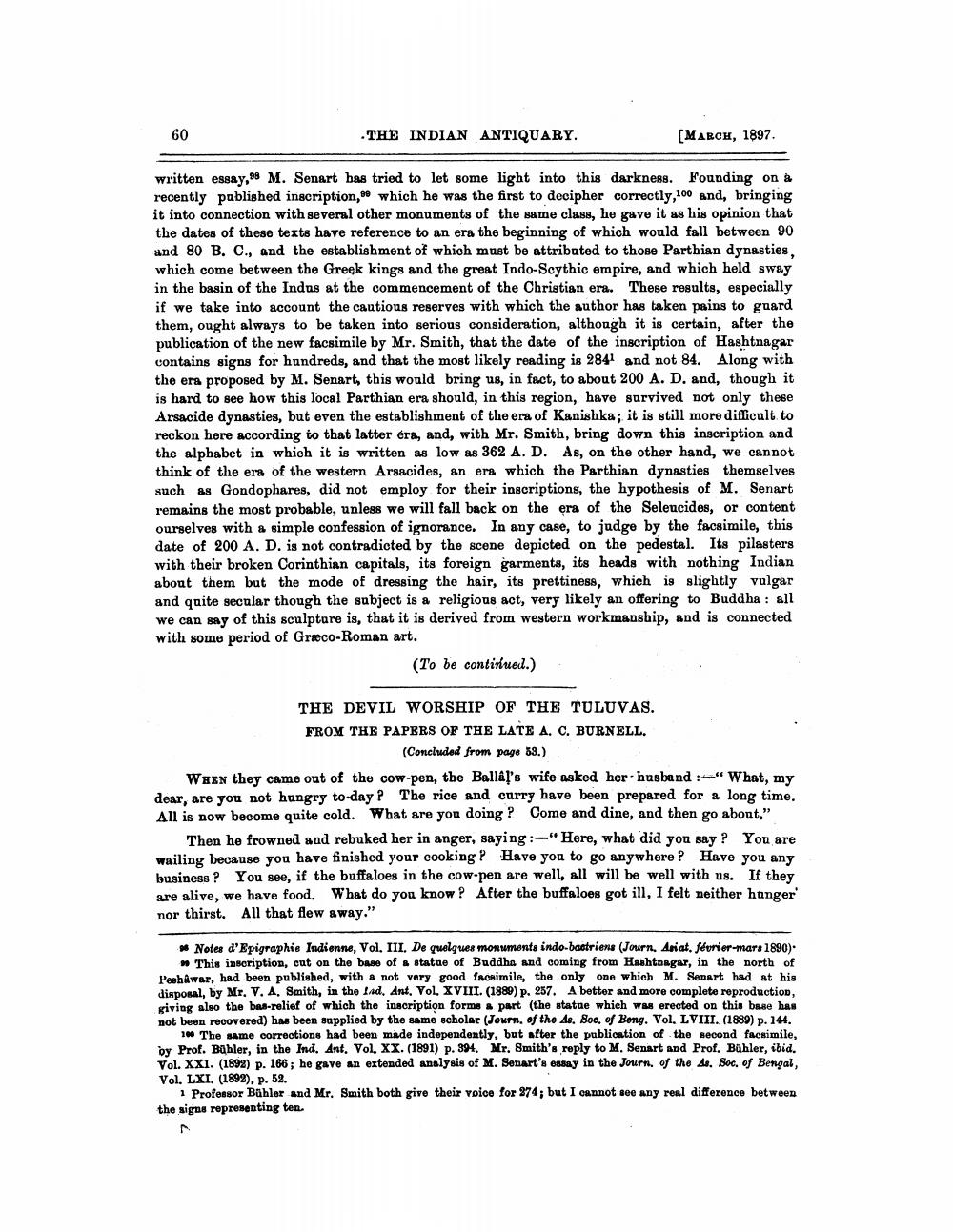________________
.THE INDIAN ANTIQUARY.
written essay, 98 M. Senart has tried to let some light into this darkness. Founding on à recently published inscription, which he was the first to decipher correctly,100 and, bringing it into connection with several other monuments of the same class, he gave it as his opinion that the dates of these texts have reference to an era the beginning of which would fall between 90 and 80 B. C., and the establishment of which must be attributed to those Parthian dynasties, which come between the Greek kings and the great Indo-Scythic empire, and which held sway in the basin of the Indus at the commencement of the Christian era. These results, especially if we take into account the cautious reserves with which the author has taken pains to guard them, ought always to be taken into serious consideration, although it is certain, after the publication of the new facsimile by Mr. Smith, that the date of the inscription of Hashtnagar contains signs for hundreds, and that the most likely reading is 2841 and not 84. Along with the era proposed by M. Senart, this would bring us, in fact, to about 200 A. D. and, though it is hard to see how this local Parthian era should, in this region, have survived not only these Arsacide dynasties, but even the establishment of the era of Kanishka; it is still more difficult to reckon here according to that latter éra, and, with Mr. Smith, bring down this inscription and the alphabet in which it is written as low as 362 A. D. As, on the other hand, we cannot think of the era of the western Arsacides, an era which the Parthian dynasties themselves such as Gondophares, did not employ for their inscriptions, the hypothesis of M. Senart remains the most probable, unless we will fall back on the era of the Seleucides, or content ourselves with a simple confession of ignorance. In any case, to judge by the facsimile, this date of 200 A. D. is not contradicted by the scene depicted on the pedestal. Its pilasters with their broken Corinthian capitals, its foreign garments, its heads with nothing Indian about them but the mode of dressing the hair, its prettiness, which is slightly vulgar and quite secular though the subject is a religious act, very likely an offering to Buddha: all we can say of this sculpture is, that it is derived from western workmanship, and is connected with some period of Græco-Roman art.
(To be continued.)
60
THE DEVIL WORSHIP OF THE TULUVAS. FROM THE PAPERS OF THE LATE A. C. BURNELL. (Concluded from page 53.)
[MARCH, 1897.
WHEN they came out of the cow-pen, the Ballal's wife asked her husband:"What, my dear, are you not hungry to-day? The rice and curry have been prepared for a long time. All is now become quite cold. What are you doing? Come and dine, and then go about."
Then he frowned and rebuked her in anger, saying:-"Here, what did you say? You are wailing because you have finished your cooking? Have you to go anywhere? Have you any business? You see, if the buffaloes in the cow-pen are well, all will be well with us. If they are alive, we have food. What do you know? After the buffaloes got ill, I felt neither hunger nor thirst. All that flew away."
se Notes d'Epigraphie Indienne, Vol. III. De quelques monuments indo-bastriens (Journ. Asiat, février-mars 1890). This inscription, cut on the base of a statue of Buddha and coming from Hashtnagar, in the north of Peshawar, had been published, with a not very good facsimile, the only one which M. Senart had at his disposal, by Mr. V. A. Smith, in the fad. Ant. Vol. XVIII. (1889) p. 257. A better and more complete reproduction, giving also the bas-relief of which the inscription forms a part (the statue which was erected on this base has not been recovered) has been supplied by the same scholar (Journ. of the As. Soc. of Beng. Vol. LVIII. (1889) p. 144.
100 The same corrections had been made independently, but after the publication of the second facsimile, by Prof. Bühler, in the Ind. Ant. Vol. XX. (1891) p. 394. Mr. Smith's reply to M. Senart and Prof. Bühler, ibid. Vol. XXI. (1892) p. 166; he gave an extended analysis of M. Senart's essay in the Journ. of the As. Soc. of Bengal, Vol. LXI. (1892), p. 52.
1 Professor Bühler and Mr. Smith both give their voice for 274; but I cannot see any real difference between the signs representing ten.




